
HMS Indefatigable was one of the Ardent-class 64-gun third-rate ships-of-the-line designed by Sir Thomas Slade in 1761 for the Royal Navy. She was built as a ship-of-the-line, but most of her active service took place after her conversion to a 44-gun razee frigate. She had a long career under several distinguished commanders, serving throughout the French Revolutionary Wars and the Napoleonic Wars. She took some 27 prizes, alone or in company, and the Admiralty authorised the issue of four clasps to the Naval General Service Medal in 1847 to any surviving members of her crews from the respective actions. She was broken up in 1816.

HMS Ajax was an Ajax-class 74-gun third-rate ship of the line of the British Royal Navy. She was built by John Randall & Co of Rotherhithe and launched on the Thames on 3 March 1798. Ajax participated in the Egyptian operation of 1801, the Battle of Cape Finisterre in 1805 and the Battle of Trafalgar, before she was lost to a disastrous fire in 1807 during the Dardanelles Operation.

HMS Minotaur was a 74-gun third-rate ship of the line of the Royal Navy, launched on 6 November 1793 at Woolwich. She was named after the mythological bull-headed monster of Crete. She fought in three major battles – Nile, Trafalgar, and Copenhagen (1807) – before she was wrecked, with heavy loss of life, in December 1810.
HMS Renown was a 74-gun third-rate ship of the line of the Royal Navy. She was to have been named HMS Royal Oak, but the name was changed to Renown on 15 February 1796. She was launched at Deptford Wharf on 2 May 1798 and served in 1800-1801 as the flagship of Sir John Borlase Warren, initially in the English Channel.

HMS Hannibal was a 74-gun third-rate ship of the line of the Royal Navy, launched on 15 April 1786, named after the Carthaginian general Hannibal. She is best known for having taken part in the Algeciras Campaign, and for having run aground during the First Battle of Algeciras on 5 July 1801, which resulted in her capture. She then served in the French Navy until she was broken up in 1824.
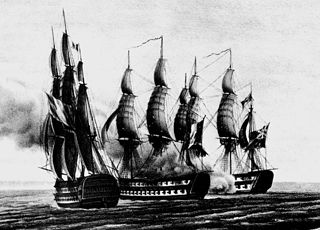
HMS Swiftsure was a 74-gun third rate ship of the line of the British Royal Navy. She spent most of her career serving with the British, except for a brief period when she was captured by the French during the Napoleonic Wars in the action of 24 June 1801. She fought in several of the most famous engagements of the French Revolutionary and Napoleonic Wars, fighting for the British at the Battle of the Nile, and the French at the Battle of Trafalgar.

HMS Foudroyant was an 80-gun third rate of the Royal Navy, one of only two British-built 80-gun ships of the period. Foudroyant was built in the dockyard at Plymouth Dock and launched on 31 March 1798. Foudroyant served Nelson as his flagship from 6 June 1799 until the end of June 1801.
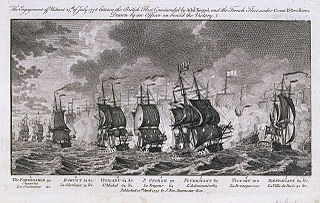
HMS Robust was a 74-gun third-rate ship of the line of the Royal Navy, launched on 25 October 1764 at Harwich. She was the first vessel of the Royal Navy to bear the name.
HMS Dictator was a 64-gun third-rate ship of the line of the Royal Navy, launched on 6 January 1783 at Limehouse. She was converted into a troopship in 1798, and broken up in 1817.

HMS Plantagenet was a 74-gun third rate ship of the line of the Royal Navy, launched on 22 October 1801 at Woolwich. She was designed by Sir William Rule as one of the 'large class' 74s, and was the only ship built to her draught. As a large 74, she carried 24-pounder guns on her upper gun deck instead of the 18-pounder guns found on the middling and common class 74s.
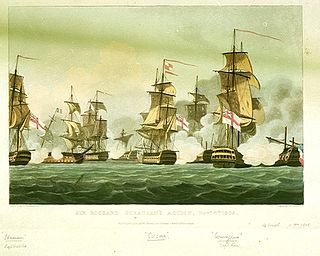
HMS Courageux was a 74-gun third rate ship of the line of the Royal Navy, launched on 26 March 1800 at Deptford. She was designed by Sir John Henslow as one of the large class 74-gun ships, and was the only ship built to her draught. Unlike the middling and common class 74-gun ships, which carried 18-pounder long guns, as a large 74-gun ship, Courageux carried 24-pounders on her upper gun deck.
HMS Spencer was a 74-gun third-rate ship of the line of the Royal Navy, launched on 10 May 1800 at Bucklers Hard. Her designer was the French émigré shipwright Jean-Louis Barrallier. She served in two major battles, Algeciras Bay and San Domingo, and in a number of other campaigns. She was broken up in 1822.

HMS Dragon was a 74-gun third rate ship of the line of the Royal Navy, launched on 2 April 1798 at Rotherhithe. She was designed by Sir William Rule, and was the only ship built to her draught.

America was a Téméraire-class 74-gun ship of the line of the French Navy. The Royal Navy captured her in 1794 at the Battle of the Glorious First of June. She then served with the British under the name HMS Impetueux until she was broken up in 1813. She became the prototype for the Royal Navy America-class ship of the line.
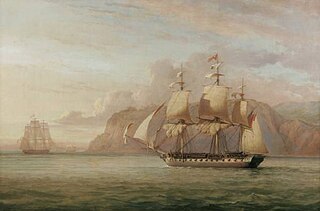
Proserpine was a 38-gun Hébé-class frigate of the French Navy launched in 1785 that HMS Dryad captured on 13 June 1796. The Admiralty commissioned Proserpine into the Royal Navy as the fifth rate, HMS Amelia. She spent 20 years in the Royal Navy, participating in numerous actions in the French Revolutionary and Napoleonic Wars, capturing a number of prizes, and serving on anti-smuggling and anti-slavery patrols. Her most notable action was her intense and bloody, but inconclusive, fight in 1813 with the French frigate Aréthuse. Amelia was broken up in December 1816.

HMS Amethyst was a Royal Navy 36-gun Penelope-class fifth-rate frigate, launched in 1799 at Deptford. Amethyst served in the French Revolutionary Wars and the Napoleonic Wars, capturing several prizes. She also participated in two boat actions and two ship actions that won her crew clasps to the Naval General Service Medal. She was broken up in 1811 after suffering severe damage in a storm.
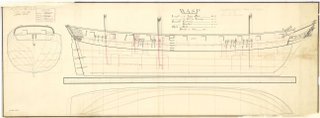
HMS Wasp was an 18-gun sloop of the British Royal Navy. She was formerly the French naval brig Guêpe, which the Navy captured in 1800. She served during the French Revolutionary and Napoleonic Wars, and was sold out of naval service in 1811.
HMS Cynthia was a ship sloop of unusual design, launched in 1796. She took part in one medal-worthy boat action and participated in captures of a number of merchant vessels, was present at two notable occasions, the surrender of the Dutch fleet in the Vlieter Incident and the capture of Alexandria, and her crew participated in two land attacks on forts. She was broken up in 1809.

HMS Medusa was a 32-gun fifth-rate frigate of the Royal Navy that served in the Napoleonic Wars. Launched on 14 April 1801, she took part in the action of 5 October 1804 against a Spanish squadron, in the River Plate Expedition in 1807, and made several captures of enemy ships, before being converted to a hospital ship in 1813. She was broken up in 1816.
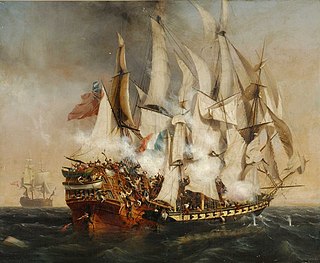
Confiance, launched in 1797, was a privateer corvette from Bordeaux, famous for being Robert Surcouf's ship during the capture of the British East India Company's East Indiaman Kent. The British Royal Navy captured Confiance in 1805, took her into service under her existing name, and sold her in 1810. Before she was sold, Confiance took part in two notable actions.

















